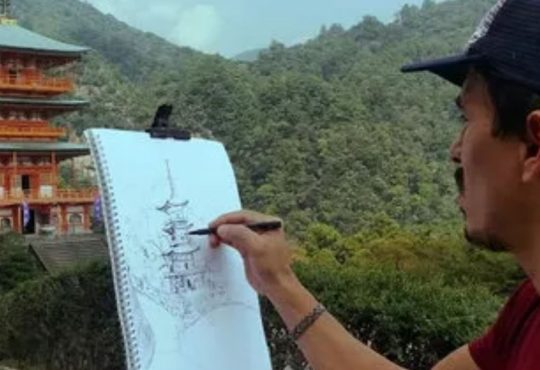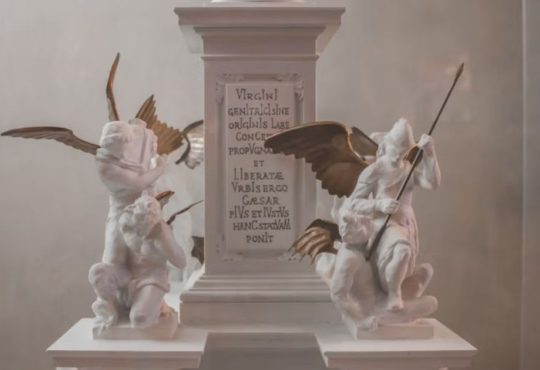Tucked behind the elegant Palazzo Sorricchio in Atri’s historic center, the Giardino Ducale Nicola e Luigi Sorricchio stands today as a harmonious blend of botanical beauty, scholarship, and urban renewal. Once lost to neglect, the garden now flourishes under the name Garden of the Renaissance—a revival project led by Hadrianum S.r.l., transforming this space into a cultural and communal gem. Beyond its manicured paths and fountains, the garden conceals layers of history spanning from ancient Roman civic infrastructure to ducal ceremony, scholarly preservation, and modern rebirth.
Beneath the serene order of this Renaissance garden, history sleeps in layers: beneath sculpted hedges and whispering fountains lie the ghostly remnants of Roman baths, cisterns, and perhaps a ginnasio, quietly keeping the secrets of Hatria’s ancient civic heartbeat.
The wonders of Giardino Ducale reveal Atri’s layered past—from a bustling Roman civic hub to ducal equestrian grounds, guided by the care of Nicola and Luigi Sorricchio. Today, the garden comes alive again, hosting cultural events, historical tours, and scholarly gatherings that celebrate the city’s rich heritage.
20 Hidden Wonders of Giardino Ducale You’ll Love
1. Originally part of Roman Hatria
The garden rests on land that once formed part of the ancient Roman settlement of Hatria, a thriving civic hub along the Adriatic coast. Archaeological evidence reveals remnants of Roman baths and intricate water systems lying beneath its surface, pointing to a sophisticated urban lifestyle that revolved around public bathing, social gatherings, and advanced engineering. These buried structures not only highlight the site’s role in antiquity but also create a layered historical backdrop, where traces of Roman ingenuity still shape the narrative of the garden today.
2. Cisterns and a possible gymnasium remain underground.
Beneath the Palazzo’s foundations, fragments of Roman engineering whisper of a bustling community long past, hinting at the daily life and ingenuity that once animated this space. Archaeological investigations point to the existence of an elaborate cistern system, a crucial element in supplying and regulating water for both daily use and public amenities. Alongside it, scholars suggest the possible remains of a gymnasium—a gymnasium that would have been central to Roman civic life, combining physical exercise with social and cultural activities. Together, these underground vestiges reinforce the idea that the site was more than just a residential or administrative space; it was a focal point of public life, embodying the Roman emphasis on health, leisure, and community.
3. Transformed into ducal equestrian grounds
With the rise of the Dukes of Atri, the site underwent a striking transformation from its Roman civic origins to a symbol of aristocratic power. The open space was repurposed as equestrian grounds, serving both ceremonial pageantry and the practical needs of military horse training. What had once been a hub of civic life evolved into a ducal courtyard, where displays of horsemanship underscored prestige and authority. This shift not only reflected the changing priorities of the era but also inscribed a new layer of meaning onto the landscape, turning it into a stage where nobility could project strength, discipline, and grandeur.
4. Renaissance-era reimagining
By the late Renaissance, the garden entered a new chapter, reshaped to embody the refined ideals of Italianate design. Its layout was carefully ordered with geometric flowerbeds, symmetrical paths, and elegant water features that spoke to the era’s fascination with harmony and proportion. Fountains and sculptures punctuated the landscape, turning the garden into a living gallery that showcased both artistic ingenuity and aristocratic grandeur. More than a space for leisure, the garden became a stage for representational display, where its owners could express their cultural sophistication and align themselves with the grandeur of Renaissance courts across Italy.
5. Acquired by historian Nicola Sorricchio
In the 18th century, the garden entered a new phase under the ownership of the Sorricchio family, when Nicola Sorricchio—a respected civic magistrate, scholar, and local historian—brought it into their domain. He integrated the grounds with the adjacent Palazzo, shaping them into both a private retreat and a place of intellectual reflection. Unlike previous owners who emphasized ceremony or display, Nicola’s vision leaned toward preservation and study. He began documenting the site’s layered history, recording its Roman origins, ducal transformations, and Renaissance redesigns. In doing so, he not only safeguarded its legacy for future generations but also established the garden as a cultural landmark tied to the scholarly pursuits of Atri’s Enlightenment-era elite.
6. Luigi Sorricchio continued the legacy.
Building on Nicola’s work, his descendant Luigi Sorricchio emerged as one of Atri’s most prominent historians. Deeply invested in the city’s past, Luigi dedicated much of his scholarship to uncovering and preserving its layered heritage. His magnum opus, Hatria = Atri, offered extensive research that connected the ancient Roman settlement of Hatria with the modern town, weaving together archaeology, archival records, and local memory. Within this work, he devoted particular attention to the garden and Palazzo, situating them within Atri’s broader civic and cultural evolution. Through his efforts, Luigi not only safeguarded the site’s historical narrative but also ensured that future generations could appreciate its role as a living chronicle of the city’s identity.
7. Nicola transcribed medieval and Roman documents.
As part of his commitment to safeguarding Atri’s past, Nicola Sorricchio dedicated himself to the painstaking transcription of medieval manuscripts and ancient Roman records. Among his most significant contributions was the preservation of the Annali Acquaviviani, a chronicle central to understanding the legacy of the Acquaviva dukes. He also compiled local epigraphy and civic records, creating a bridge between fragmented inscriptions, archival material, and living historical memory.
Many of these transcriptions survive today in regional archives and, more recently, in digitized collections, where they continue to serve as invaluable resources for scholars. Through this meticulous work, Nicola not only preserved fragile sources at risk of being lost but also provided the foundations for future research into Atri’s civic, cultural, and political history.
8. Luigi published a foundational monograph in 1911
In 1911, Luigi Sorricchio solidified his reputation as Atri’s foremost historian with the publication of a landmark monograph. This ambitious volume traced the city’s trajectory from prehistory through the Roman era, weaving together studies of architecture, urban planning, coinage, and even the evolving layout of the garden itself. Far more than a local chronicle, the work positioned Atri within the broader currents of Mediterranean history, highlighting its civic and cultural significance across centuries. More than a century later, Luigi’s monograph remains a cornerstone for scholars, serving as both a meticulous record of the city’s material past and a testament to his dedication to preserving Atri’s identity for future generations.
9. The garden fell into dire neglect by the early 21st century.
By the early 2000s, the garden’s fortunes had sharply declined, marking one of the most challenging periods in its long history. Although a custodial agreement placed it under municipal oversight, upkeep was minimal and inconsistent. The once-elegant grounds became overgrown with weeds and invasive plants, while sections of the space were misused as an informal dumping ground. Fountains and pathways deteriorated, sculptures fell into disrepair, and the site gradually lost its role as a place of civic pride. By 2019, public access was cut off entirely, leaving the garden hidden behind locked gates—a silent reminder of neglect rather than the vibrant historical landscape it had once represented.
10. Privately acquired and restored
A decisive turning point came when the property passed from the hands of neglect into those of Hadrianum S.r.l., under the leadership of entrepreneur Piero Pavone. Recognizing both its cultural significance and its fragile state, Pavone purchased the garden from the Sorricchio and Arlini heirs, ending years of uncertainty over its future. Rather than waiting for slow-moving public initiatives, he undertook a privately funded restoration, channeling resources into clearing the overgrowth, stabilizing historic structures, and reviving the garden’s Renaissance layout. This initiative not only preserved an endangered landmark but also demonstrated how private stewardship could succeed where municipal care had faltered, giving the site new life as a restored jewel of Atri’s heritage.
11. Four-year restoration process
The revival of the garden unfolded over nearly four years, a careful effort that balanced structural conservation with aesthetic renewal. The first stages focused on clearing decades of overgrowth and debris, followed by the stabilization of crumbling walls, fountains, and pathways that had long been left to decay. Skilled landscapers and artisans then worked to re-establish the garden’s Renaissance-inspired layout, reintroducing geometric beds, trimmed hedges, and restored water features that once defined its elegance. By the time it reopened, the project had not only revived the garden’s visual beauty but also restored its historical presence within Atri, allowing the community to once again engage with a space that reflects both civic memory and cultural pride.
12. Renamed the ‘Garden of the Renaissance’
The new identity reflects both its Renaissance layout and its broader cultural rebirth as a public forum for local identity and artistic expression.
13. Hosted literary-historical event in 2025
Adriano Influencer ante Litteram, held in June 2025, featured readings and scholarly dialogue on Emperor Hadrian, connecting the garden with Atri’s Roman heritage.
14. Serves as a living heritage venue
The garden now stages cultural events, art exhibitions, and academic panels—merging its historical layers with modern creativity and community participation.
15. Site marries Roman, ducal, and Renaissance layers.
Its design simultaneously reflects civic Roman foundations, ducal service use, and Renaissance elegance, creating a multi-temporal urban space.
16. Connected architecturally to Palazzo Sorricchio
Its placement adjacent to the Palazzo emphasizes continuity and creates a courtyard combining residential, scholarly, and garden use.
17. Digital archives are now publicly available.
Manuscripts transcribed by Nicola and other Sorricchio documents are now digitized and accessible through the national Italian digital library system.
18. Showcases local civic pride
Characterized by its structured walkways, elaborate fountains, and harmonious proportions, the garden’s Italianate style captures the refinement and splendor of 16th- and 17th-century noble aesthetics. The revival has sparked renewed local commitment to heritage and interest in preserving Atri’s past through active stewardship and volunteering.
19. Environmental renewal and safety
The restoration cleared decades of discarded debris and invasive growth, revitalizing the garden into a thriving, verdant space where visitors can safely enjoy its beauty and serenity.
20. Bureaucratic tension during restoration
The process wasn’t without challenges: municipal office delays and administrative resistance highlighted broader issues in Italian heritage oversight.
A Living Chronicle of Atri’s Past and Present
The Giardino Ducale Nicola e Luigi Sorricchio is not just a garden—it is a living chronicle of Atri’s multi-layered past. From its roots in Roman Hatria to ducal use, Renaissance reimagining, scholarly preservation, and eventual modern restoration, the site embodies an extraordinary continuum of civic life and heritage. Today, as the Garden of the Renaissance, it stands not only as a beautiful urban retreat but as a vibrant cultural hub where history and community intersect.
This revival is a model of civic stewardship: private initiative brought decayed heritage back into public life, turning forgotten ruins into a forum for education, art, and memory. Whether traced through underground cisterns or woven into guided lectures beneath ancient trees, the garden offers visitors a tangible journey through centuries—reminding us that history can bloom anew when nurtured with care and purpose.





